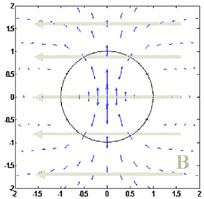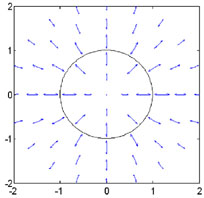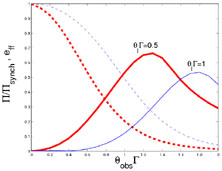


F. Polarization from Relativistically Moving Sources
Polarization can provide information on both the emission process and on the geometry of the emitting regions. Usually the observed polarization is obtained by first integrating the Stokes parameters of the radiation emitted by the individual electrons over the electron's distribution. This yields the local polarization. Then we integrate over the emitting region to obtain the global polarization. In GRBs (both in the prompt emission and in the afterglow) the emitting regions move relativistically towards the observed. The implied Lorentz transformations play a very important role in the second integration as they change the direction of propagation of the photons and hence the direction of the local polarization. The final results are sometimes surprising and counter intuitive. For example even if the intrinsic (local) emission is 100% polarized in the same direction the integration over the emitting region would reduce this to 70% polarization. I consider polarization from synchrotron emission here, but the results can be easily applied to IC as well. I apply the results derived in this section to the possible polarization from the prompt emission and from the afterglow in the corresponding sections Section VIE and VIIJ.
As an example I consider synchrotron emission. Synchrotron emission is polarized with and the intrinsic local polarization level depends on the spectral index of the energy distribution of the emitting electrons, p, [361]. For typical values (2 < p < 3) it can reach 75%. The polarization vector is perpendicular to the magnetic field and, of course, to the direction of the emitted radiation. The formalism can be easily adopted also to Inverse Compton for which the intrinsic local polarization is higher and could reach 100% when the photons are scattered at 90°.
Consider first a case where the magnetic field is uniform locally
(over a regions of angular size
 -1). This
could happen,
for example, if we have an ordered magnetic field along the
-1). This
could happen,
for example, if we have an ordered magnetic field along the
 direction and the observer is more than
direction and the observer is more than
 -1 away from
the symmetry axis. This would be the case within internal shocks
if the magnetic field is dragged from the source or within several
Poynting flux dominated models. The locally emitted polarization
is uniform and is in the plane of the sky and perpendicular to the
direction of the magnetic field. In a Newtonian system it would
combine so that the observed polarization equals the emitted one.
However, the Lorentz transformations induce their own signature on
the observed polarization
[133,
134]. This is
depicted in Fig. 15. It is clear from this
figure that the polarization vector varies along the observed
region (whose angular size is 1 /
-1 away from
the symmetry axis. This would be the case within internal shocks
if the magnetic field is dragged from the source or within several
Poynting flux dominated models. The locally emitted polarization
is uniform and is in the plane of the sky and perpendicular to the
direction of the magnetic field. In a Newtonian system it would
combine so that the observed polarization equals the emitted one.
However, the Lorentz transformations induce their own signature on
the observed polarization
[133,
134]. This is
depicted in Fig. 15. It is clear from this
figure that the polarization vector varies along the observed
region (whose angular size is 1 /
 . Consequently the
observed global polarization will be smaller than the local
polarization.
. Consequently the
observed global polarization will be smaller than the local
polarization.
 |
Figure 15. Polarization
from a uniform magentic field (following
[134]).
The circle marks the and angle where the matter moves at an angle
|
The observed stokes parameters are weighted averages of the local
stokes parameters at different regions of the shell. The
instantaneous polarization is calculated using the instantaneous
observed flux
F (y,
T)
(y,
T)  (1 +
y)-(3+
(1 +
y)-(3+ ), with
), with
 the relevant spectral
index at this segment, as the weights, where
y
the relevant spectral
index at this segment, as the weights, where
y  (
(
 )2 and
T is the observer time. The time integrated polarization is
calculated using the fluences as weights:
)2 and
T is the observer time. The time integrated polarization is
calculated using the fluences as weights:
 0
0 F
F (y,
T) dT
(y,
T) dT  (1 + y)-(2+
(1 + y)-(2+ ).
).
The fluxes depend on how the intensity varies with the magnetic
field. For I
 B0,
which is relevant for fast
cooling 5 (and the prompt
GRB), the time integrated stokes parameters (note that V = 0 as
the polarization is linear) and polarization are given by:
B0,
which is relevant for fast
cooling 5 (and the prompt
GRB), the time integrated stokes parameters (note that V = 0 as
the polarization is linear) and polarization are given by:
 |
(39) |
and the relative polarization is given by
 |
(40) |
where  p =
p =
 + arctan((1 -
y) / (1 + y)
cot
+ arctan((1 -
y) / (1 + y)
cot )
[134]
(see also
[228]).
For
)
[134]
(see also
[228]).
For  = 1 Eqs. 39-40 yield a
polarization level of
= 1 Eqs. 39-40 yield a
polarization level of  /
/
 synch
synch
 60%. I.e. 60%
of the maximal synchrotron polarization, or an overall
polarization of ~ 45%. Taking the exact values of
60%. I.e. 60%
of the maximal synchrotron polarization, or an overall
polarization of ~ 45%. Taking the exact values of
 and the dependence of
I
and the dependence of
I on
B for fast cooling and p = 2.5
results in an overall polarization of ~ 50%
[134,
275].
on
B for fast cooling and p = 2.5
results in an overall polarization of ~ 50%
[134,
275].
It turns out that one can get a polarized emission even from random magnetic field Gruzinov and Waxman [148] and Medvedev and Loeb [255]. This happens if the system has non spherical geometry. Consider a two dimensional random magnetic field which is in the plane of the shock and assume that the correlation length of this magnetic field is very short compared to all other length scales in the system. The Lorentz transformation induce in this case a radial polarization pattern going out from the center (where the velocity of the matter is towards the observer and the polarization vanishes). This polarization pattern is shown in Fig. 16. It is clear that a simple integration over this pattern will lead to a vanishing polarization.
 |
Figure 16. Polarization
from a random magnetic field in the plane of the shock
[275].
The solid circle marks the and angle where the matter moves at an angle
|
However, a net polarization can arise in several cases if the overall symmetry is broken. Polarization will arise if (see Fig. 16):
We observe a jet in an angle so that only a part of
the jet is within an angle of
 -1.
-1.
If the emission is
nonuniform and there are stronger patches with angular size
smaller than
 -1from
which most of the emission arise.
-1from
which most of the emission arise.
We observe a standard jet whose emission is angle
dependent and this dependence is of the order of
 -1.
-1.
Ghisellini and Lazzati
[126],
Gruzinov
[147],
Sari
[365],
Waxman
[432]
suggested that polarization can arise from a jet even if the
magnetic field is random. Nakar et al.
[275] considered
a random magnetic field that remains planner in the plane of the
shock (for a three dimensional random magnetic field the
polarization essentially vanishes). For
I
 B0 the
degree of observed polarization of the emission emitted from a
small region at angle y is:
B0 the
degree of observed polarization of the emission emitted from a
small region at angle y is:
 (y) /
(y) /
 synch =
min(y, 1 / y).
The overall time integrated stokes parameters are:
synch =
min(y, 1 / y).
The overall time integrated stokes parameters are:
 |
(41) |
where
P' ', m =
P'
', m =
P' ', m(y,
', m(y,
 ) is the
emitted power at the synchrotron frequency in the fluid rest frame. For a
top-hat jet with sharp edges
P'
) is the
emitted power at the synchrotron frequency in the fluid rest frame. For a
top-hat jet with sharp edges
P' ', m is
constant for any
y and
', m is
constant for any
y and  within the jet and zero otherwise. For a structured jet
P'
within the jet and zero otherwise. For a structured jet
P' ', m
depends on the angle from the jet axis.
', m
depends on the angle from the jet axis.
The maximal polarization is observed when one sees the edge of the
jet. The probability to see the edge of a top-hat jet with sharp
edges and an opening angle
 j
j
 >> 1 is
negligible. On the other hand a jet with
>> 1 is
negligible. On the other hand a jet with
 j
j
 << 1 is not
expected. Thus the only physical cases in which we can
expect a large polarization are
1
<< 1 is not
expected. Thus the only physical cases in which we can
expect a large polarization are
1 
 j
j
 < a few.
< a few.
Fig. 17 depicts the time integrated polarization
and the efficiency from sharp edged jets with different opening
angles as a function of the angle between the jet axis and the
line of sight,
 obs. The
efficiency, eff is
defined to be the ratio between the observed fluence at
obs. The
efficiency, eff is
defined to be the ratio between the observed fluence at
 obs and the
maximal possible observed fluence at
obs and the
maximal possible observed fluence at
 obs = 0. In
all these cases the polarization is peaked
above 40%, however the efficiency decrease sharply as the
polarization increase. Thus the probability to see high
polarization grows when
obs = 0. In
all these cases the polarization is peaked
above 40%, however the efficiency decrease sharply as the
polarization increase. Thus the probability to see high
polarization grows when
 j
decrease. The probability that
j
decrease. The probability that
 obs is such
that the polarization is larger than 30% (.
obs is such
that the polarization is larger than 30% (.
 synch) while
eff > 0.1 is 0.68, 0.41, 0.2 & 0.08 for
synch) while
eff > 0.1 is 0.68, 0.41, 0.2 & 0.08 for
 j
j
 = 0.5, 1, 2, 4
respectively. In reality this probability will be smaller, as the
chance to observe a burst increases with its observed flux.
= 0.5, 1, 2, 4
respectively. In reality this probability will be smaller, as the
chance to observe a burst increases with its observed flux.
 |
 |
Figure 17. The time integrated polarization
(solid line) and
the efficiency (dashed line) as a function of
|
These later calculations also apply for IC emission [71, 211]. However, in this case the intrinsic local polarization is around 100% and hence one can reach a maximal polarization of ~ 70%.
Polarization could also arise if the magnetic field is uniform
over random patches within a region of size
 -1. Here it
is difficult, of course to estimate the total polarization without
a detailed model of the structure of the jet
[148].
-1. Here it
is difficult, of course to estimate the total polarization without
a detailed model of the structure of the jet
[148].